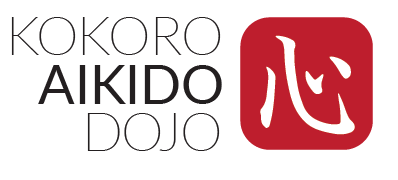This is a list of Japanese terms which you will hear used in the dojo.
By studying these definitions you will discover many facets of Aikido philosophy.
It is important to your practice that you have a basic understanding of them.
Quotation marks indicate the words of the Founder.
0-9
A
- Atemi Waza
- Techniques of striking.
B
- Bokken
- Wooden practice sword.
- Budo
- Literally to stop the thrusting spear. “A mind to serve for the peace of all humanity is needed in Aikido, not the mind of one who wished to be strong and only practices to defeat an opponent. There are neither opponents nor enemies for true Budo. Therefore to compete in techniques, winning or losing, is not true Budo. True Budo knows nodefeat. Never defeated means never fighting.”
- Bushido
- The way of chivalry.
C
D
- Deai
- The moment of truth. The moment of the meeting of two forces.
- Deshi
- Student.
- Dojo
- The place where the way is revealed. A place for the strengthening and refinement of spirit, mind and body.
E
F
G
H
- Hakama
- Wide skirted pants worn over the gi. You will be expected to wear hakama (dark blue or black) after receiving the 6’h kyu grade.
- Hanmi
- The relaxed triangular stance of Aikido. It is stable yet flexible enough to move quickly in any direction. All technique begins, moves through and ends in hanmi.
- Hanmi-Handachi
- Techniques practiced with nage sitting and uke standing.
- Hara
- The lower abdomen. The center of life energy, physical and spiritual. All movement must originate from this point.
I
- Irimi
- Entering, moving into and through the line of attack with no thought of escape.
J
- Jiyu Waza
- Free technique. In testing usually against one opponent.
- Jo
- Short staff
- Jo dori
- Techniques of staff taking.
K
- Kamae
- A posture or stance of readiness. In each kamae there are different positions for the hands or weapon. Jodan – high position; Chudan – middle position;Gedan – lower position.
- Kata dori
- Shoulder grab
- Katate dori
- Wrist grab
- Keiko
- Study or practice. The deeper meaning is to return to the origin. Through the study of the past and appreciation for its experience we can understand the present and refine our spirit.
- Kiai
- The release of spiritual and physical power in the form of a piercing scream originating in the hara.
- Kohai
- Junior student. Those who begin their study of Aikido after you. You owe them your help and support.
- Kokyu
- The power of breath, renewal of life force.
- Kumi Tachi
- Paired sword practice
- Kyu
- White belt grade
L
M
- Maai
- The distance of time and space between two forces. The movement of the mind, the stream of spirit and their direction, as well as physical distance, determines the balanced and proper use of space.
- Mae ukemi
- Forward rolls
- Migi
- Right
- Misogi
- Purification of mind, body, and spirit. Sweating is misogi; cleaning is misogi; fasting is misogi; keiko is misogi.
- Munetsuki
- A straight punch to the chest or solar plexus.
- Mushin
- No mind, a mind without ego. A mind like a mirror which reflects and does not judge.
- Musubi
- Opposites are but different images of the same reality Musubi is the process of their unification. It is the movement of the spiral.
N
- Nage
- A throw. One who throws.
O
- Omoto
- To the front.
- O’Sensei
- Great teacher – the title used for the Founder of Aikido.
P
Q
R
- Randori
- Free technique against multiple attack.
- Rei
- To bow.
- Reigi
- Rei can also be translated as holy spirit; gi as manifestation. When used together the words mean proper etiquette, respecting the creative force and spirit which is the same in all of us.
- Ryokata dori
- Grabbing both shoulders.
- Ryote dori
- Grabbing both wrists.
S
- Samurai
- Originally comes from the verb meaning to serve. One who has the duty and responsibility to protect society.
- Seiza
- Formal sitting position.
- Sempai
- Senior student: Those who began their study of Aikido before you. You owe them your respect for their experience.
- Sensei
- Teacher, one who gives guidance along the way. Literally – born before.
- Senshin
- A purified heart and spirit, enlightened attitude.
- Shiho-nage
- Four directions throw.
- Shikko
- Knee walking.
- Shomen
- The upper seat, the shrine which houses the picture of the Founder and the spirit of Aikido.
- Shomenuchi
- Strike or cut to the top of the head.
- Soto
- Out/outside, movement to the side of Uke.
- Suburi
- Practice with sword or bokken in which the same cut is repeated again and again. An excellent purification/meditation exercise.
- Suwariwaza
- Techniques which begin with both opponents in seiza and are executed from the knees.
T
- Tachi
- Japanese long sword.
- Tachi dori
- Techniques of sword taking.
- Tanden
- The hara.
- Tanto
- Knife
- Tanto dori
- Techniques of knife taking.
- Tenkan
- Turning to dissipate force.
U
- Uke
- One who receives. The person being thrown.
- Ukemi
- Techniques of falling. The art of protecting oneself from injury. The first and most important step to developing strong Aikido technique is developing good ukemi.
- Ura
- To the rear.
- Ushiro
- From behind.
V
W
- Waza
- Technique
X
Y
- Yokomenuchi
- Strike or cut to the side of the head or neck.
- Yudansha
- Black belt rank holders.
Z
- Zanshin
- Continuity; remaining aware and prepared for the next action.
